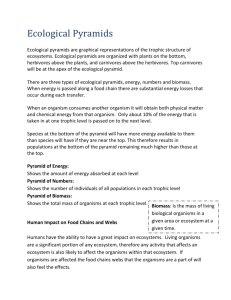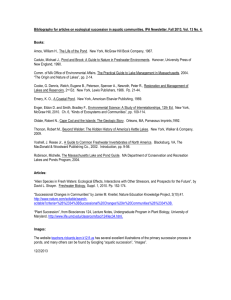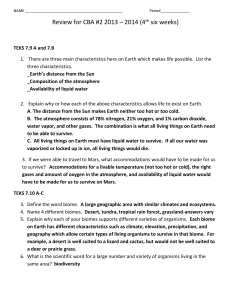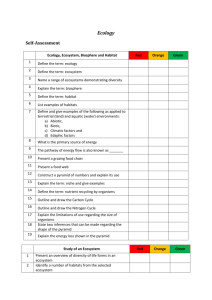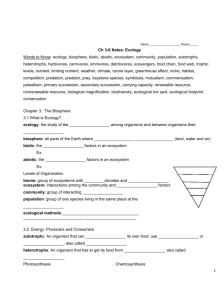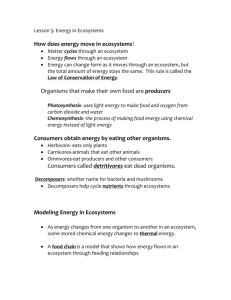ecology packet
advertisement
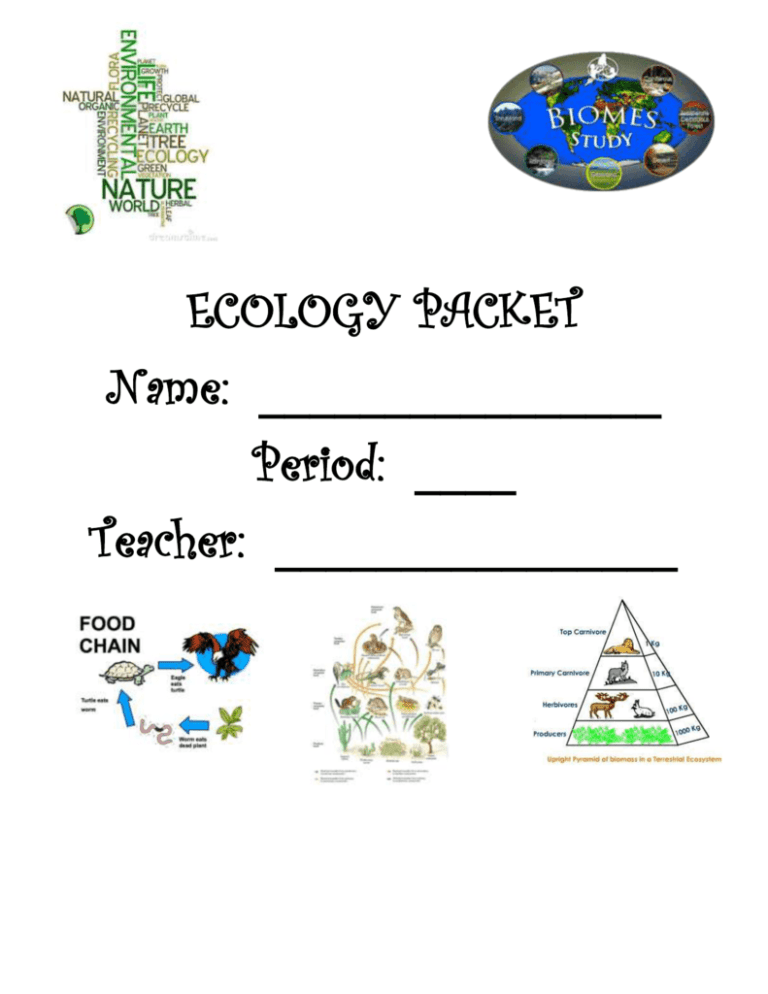
ECOLOGY PACKET Name: ________________ Period: ____ Teacher: ________________ STUDENT UNIT PLAN 9: ECOLOGY Vocabulary Terms: ecology individual species population community ecosystem biome biosphere food web food chain autotroph producer heterotroph consumer decomposer pollution niche habitat resources renewable non-renewable trophic levels prey predator competition density-dependent density-independent carrying capacity limiting factor exponential growth immigration emigration biotic factor abiotic factor ecological pyramid biomass ecological succession primary succession pioneer species secondary succession ---------------------------------------------------------------------------------------------------------------------------------------------------Introduction to Ecology Assignment(s) My level of # of 11B, 11D, 12C, 12D, and 12F understanding Test or Questi ons 1. Can I identify the levels of ecological organization? 2. How do biotic and abiotic factors influence an ecosystem? 3. Can I analyze the flow of matter through food chains, food webs and ecological pyramids? 4. Can I identify and discuss the different relationships between organisms in the ecosystem by using food chains, food webs and ecological pyramids? 5. Can I analyze ecological energy pyramids and discuss how the amount of available food energy changes at each trophic level (10% rule)? 6. How does density-dependent and density-independent limiting factors affect population growth and survival? 7. What role does ecological succession play in changing populations? 8. I can identify and describe parasitism, commensalism, mutualism, predation, and competition. 9. I understand the importance of ecosystem stability and can discuss the effects of a changing environment such as global warming, pollution, etc. 10. I can explain why plant and animal adaptations allow them to survive in their specific biomes. 11. I know the carbon and nitrogen cycles and can explain the effects of a disruption to each cycle. Page 2 Ecology is _________________________________________________________________________________________ __________________________________________________________________________________________________. The level of hierarchy or organization is as follows: _______________ ________________ _________________ _____________________ ________________________ ______________________________________. Ecology contain both ______________________ and __________________________ factors. Examples of biotic factors are _________________________________ and abiotic factors are _________________________________________. Biomes are _____________________ communities characterized by a certain type of ______________ and _______________. TUNDRA: TROPICAL RAIN FOREST: DESERT: TEMPERATE DECIDUOUS Soil: ____________________ Soil: ____________________ Soil: ____________________ FOREST: Plant Life: ________________ Plant Life: ________________ Plant Life: ________________ Soil: ____________________ _________________________ _________________________ _________________________ Plant Life: ________________ Animal Life: ______________ Animal Life: ______________ Animal Life: ______________ _________________________ ________________________ _________________________ _________________________ Animal Life: ______________ Climate: ________________ Climate: _________________ Climate: _________________ _________________________ Climate: _________________ Location: ________________ Location: ________________ Location: ________________ Location: ________________ TAIGA (BOREAL) FOREST: GRASSLANDS: CONIFEROUS FOREST: BIOSPHERE: _____________ Soil: ____________________ Soil: ____________________ Soil: ____________________ _________________________ Plant Life: ________________ Plant Life: ________________ Plant Life: ________________ _________________________ _________________________ _________________________ _________________________ _________________________ Animal Life: ______________ Animal Life: ______________ Animal Life: ______________ _________________________ _________________________ _________________________ Climate: _________________ Climate: _________________ Climate: _________________ Location: ________________ Location: ________________ Location: ________________ Page 3 Within each biome there are intricate patterns of how the flow of matter (energy) takes place. There are food chains, food webs and various types of ecological pyramids used to demonstrate this process. First let’s look at the various ways that organisms obtain nutrition. The main source of energy for all life is the _________. The sun is used to carry out the process of __________________________________________ by plants known as _______________________ or producers. Autotrophs _______________________________________________. Autotrophs are then consumed by the ____________________________________ or consumer. There are various types of consumers or heterotrophs. They are as follows: Herbivore __________________________________________________________________________________ Carnivore __________________________________________________________________________________ Omnivore __________________________________________________________________________________ Detritivore __________________________________________________________________________________ Decomposer ________________________________________________________________________________ All of these organisms are involved in some sort of food chain or food web. What is a food chain? _________________________________________________________________________________________ Choose one food chain from the food web below and illustrate it below: What is a food web? _________________________________________________________________________________________ Only _______% of the energy stored in a trophic level is passed on to the next level because the majority of the energy is used by the organism to carry out life processes such as _______________, ________________ and ____________________. Some of the remaining energy is released into the environment as __________. Page 4 Biomes Concept Map (Pgs. 100-104) WORD BANK: North Africa Eastern USA Central USA Canada Central Africa Elephant Giraffe Prairie Dogs Lion Moose Squirrels Reptiles Monkeys Pine Trees Dry Climate Canopy Rainfall Page 5 Cactus Equator Maple Trees Seasons Farmland WHAT ARE SOME PARTS OF A FOOD CHAIN AND A FOOD WEB? Plants use light energy from the sun to make food. The food is stored in the cells of the plant. Plants are called producers because they make their own food. Some of the stored energy in the food plants make is passed on to the animals that eat the plants. Planteating animals are called primary consumers. Some of the energy is passed on to the animals that eat the primary consumer. Animals that eat other animals are called secondary consumers. The pathway that food takes through an ecosystem is called a food chain. A food chain also shows the movement of energy from plants to plant eaters and then to animal eaters. An example of a food chain can be written as follows: Seeds Sparrow Hawk Some of the food energy in the seeds moves to the sparrow that eats the seeds and then some of the food energy is then passed on to the hawk that eats the sparrow. Because a hawk eats animals other than sparrows, you could make a food chain for each animal that the hawk eats. If all of the food chains were connected, the result would be called a food web. A food web is a group of connected food chains. The food web shows the many energy relationships within an ecosystem. Study the food chains listed below and then complete the table. Place an X in each box for all the things that each animal listed on the left side eats. FOOD CHAINS: 1. 2. 3. 4. 5. 6. Plant parts land snail mouse raccoon Plant parts sparrow hawk Plant parts rabbit fox Plant parts cricket robin fox Plant parts earthworm snake hawk fox Plant parts small insects mouse owl 7. Plant parts mouse fox 8. Plant parts raccoon fox 9. Plant parts rabbit snake 10. Plant parts rabbit hawk 11. Plant parts rabbit owl fox 12. Plant parts mouse snake owl Sparrow Land Snail Rabbit Cricket Earthworm Small Insects Mouse Raccoon Hawk Snake Robin Owl Page 6 Land Snail Sparrow Snake Robin Raccoon Rabbit Plant parts Owl Mouse Small Insects Hawk Earthworm Cricket Living Things in the Forest that Animals Eat Animals that live in a forest ecosystem and eat the following organisms Using the food chains from Page 5, you will now construct a food web. The first food chain has been done for you as an example. Use a different color to draw your arrows for each food chain. Remember to work in order so you can tell when you have used all of the food chains. Also, draw lines so that they can “BEND” around the circle. DO NOT CUT THROUGH A CIRCLE. This will make it easier to read the food web when you are finished. Create a legend that indicates the colored lines that corresponds with each food chain. Page 7 ECOLOGICAL PYRAMIDS An ecological pyramid is a diagram that shows the _____________________________________________________________ that is contained within each trophic level in a food chain or food web. There are several types of Ecological Pyramids. The first type is a Pyramid of Energy which _____________________________________________________________________________________. Label the Energy Pyramid: Another type of pyramid is the Pyramid of Numbers which ____________________________________ _________________________________________ Draw a Pyramid of Numbers by filling in the missing organisms. Another type of pyramid is the Pyramid of Biomass which represents ___________________________ _________________________________________ _________________________________________ Note that biomass is typically expressed using grams or kilograms. Which organism would have the smallest amount of biomass? ____________________ Pyramid of Biomass Page 8 SYMBIOSIS describes a _____________________________________________________ between 2 ________________________ in which at least one of the organisms involved benefits. There are 3 types of symbiosis: ___________________________________, ___________________________________ and __________________________________________. PARASITISM COMMENSALISM Example Example Definition MUTUALISM Other types of relationships within an ecosystem are: _________________________ and ____________________________. Predation: _________________________________________________________________________________________________ Give your own example of Predation: __________________________________________________________________________ Competition: _______________________________________________________________________________________________ Give your own example of Competition: __________________________________________________________________________ Page 9 PREDATION OR STARVATION: Page 10 ECOLOGICAL SUCCESSION: Ecosystems are constantly changing in response to natural and human disturbances. As an ecosystem changes, older inhabitants gradually die off and new organisms move in causing further changes within the communities. This series of changes is called ___________________________ _________________________. There are different types of ecological succession. The first is called a ___________________________ succession. This is when _______________________________________ __________________________________________________________________________________________________________. Within this environment, there are ______________________ organisms. They are the _____________ to populate an area. What are the pioneer organisms in this picture? _________________________ A second type of changing ecosystem is a ______________________________________ succession. This is when ______________ ___________________________________________________________________________________________________________. Page 11 Ecological Succession Worksheet Succession, a series of environmental changes, occurs in all ecosystems. The stages that any ecosystem passes through are predictable. In this activity, you will place the stages of succession of two ecosystems into sequence. You will also describe changes in an ecosystem and make predictions about changes that will take place from one stage of succession to another. The evolution of a body of water from a lake to a marsh can last for thousands of years. The process cannot be observed directly. Instead, a method can be used to find the links of stages and then to put them together to develop a complete story. The water level of Lake Michigan was once 18 meters higher than it is today. As the water level fell, land was exposed. Many small lakes or ponds were left behind where there were depressions in the land. Below are illustrations and descriptions of four ponds as they exist today. Use the illustrations and descriptions to answer the questions about the ponds. Pond A: Cattails, bulrushes, and water lilies grow in the pond. These plants have their roots in the bottom of the pond, but they can reach above the surface of the water. This pond is an ideal habitat for the animals that must climb to the surface for oxygen. Aquatic insect larvae are abundant. They serve as food for larger insects, which in turn are food for crayfish, frogs, salamanders, and turtles. Pond B: Plankton growth is rich enough to support animals that entered when the pond was connected to the lake. Fish make nests on the sandy bottom. Mussels crawl over the bottom. Pond C: Decayed bodies of plants and animals form a layer of humus over the bottom of the pond. Chara, branching green algae, covers the humus. Fish that build nests on the bare bottom have been replaced by those that lay their eggs on the Chara. Pond D: The pond is so filled with vegetation that there are no longer any large areas of open water. Instead, the pond is filled with grasses. The water dries up during the summer months. Page 12 Using the information from the Ecological Successions Worksheet, answer the following questions. 1. Write the letters of the ponds in order from the youngest, to the oldest. 2. Black bass and bluegill make their nests on sandy bottoms. In which pond would you find them? Pageblue 11 gill as the floor of the ponds fills with 3. What will happen to the black bass and organic debris? 4. Golden shiner and mud minnows lay their eggs on Chara (green algae). In which pond would you find them? 5. Some amphibians and crayfish can withstand periods of dryness by burying themselves in mud. In which pond(s) would they survive? 6. Dragonfly nymphs spend their early stages clinging to submerged plants. Then, they climb to the surface, shed their skins, and fly away as dragonflies. Which pond is best suited for dragonflies? 7. In which pond will gill breathing snails be replaced by lung breathing snails that climb to the surface to breathe? 8. Some mussels require a sandy bottom in order to maintain an upright position. In which pond will they die out? Page 13 The climax community in the area of Arkansas is an oak-hickory forest. After the ponds are filled in, the area will undergo another series of stages of succession. This is illustrated below. Briefly explain what is happening in the diagram at each number. 1. __________________________________________________________________ __________________________________________________________________ 2. ___________________________________________________________________ ___________________________________________________________________ 3. ___________________________________________________________________ ___________________________________________________________________ 4. __________________________________________________________________ ___________________________________________________________________ 5. ___________________________________________________________________ ____________________________________________________________________ Page 14 CYCLES OF MATTER: In ecosystems matter is constantly being recycled. Elements, chemical compounds and other forms of matter are passed from one organism to another and from one part of the biosphere to another through biogeochemical cycles. There are several ways this happens. CARBON CYCLE Diagram Steps of the Process Definition WATER CYCLE Page 15 NITROGEN CYCLE POPULATION ECOLOGY: The study of how __________________________________________________________ living together in groups change over time. THREE CHARACTERISTICS OF POPULATIONS are….. 1. _______________________________________ which describes an area inhabited by a population. 2. _______________________________________ describes the number of individuals per unit area, 3. _______________________________________ describes the rate at which a population changes in size. FACTORS THAT CAN AFFECT THE SIZE OF A POPULATION ARE….. 1. ____________________________________ which references the number of offspring born each year. 2. ____________________________________ which references the number of organisms that die each year. 3. ____________________________________ which references the movement of people into an area. 4. ____________________________________ which references the movement of people out of an area. When studying the change in sizes of populations, ecologists need to take into account factors that can limit a population’s size called limiting factors. There are 2 factors that can limit the size of a population: 1. ____________________________________________________ (affect larger populations) * _______________________________________ * _______________________________________ * _______________________________________ * _______________________________________ 2. ____________________________________________________ (affect all populations regardless of size) * __________________________________________ * __________________________________________ * __________________________________________ * __________________________________________ RENEWABLE vs NON-RENEWABLE RESOURCES: 1. Renewable: _____________________________________________________________________________________________ 2. Non-Renewable: _________________________________________________________________________________________ BIODIVERSITY: _____________________________________________________________________________________________ ___________________________________________________________________________________________________________ ___________________________________________________________________________________________________________ ___________________________________________________________________________________________________________ Page 16 SELF-QUIZ: 1. On the leaves of many plants, pores open during the night and close during the day. This response allows the plant to _____. A. use its roots to eliminate waste B. wilt at night from colder temperatures C. produce more flowers for reproduction D. reduce water lost by transpiration 2. An eagle and a grizzly bear both feed on the same species of salmon in the same location. Which type of symbiotic relationship is displayed by the eagle and the bear? A Competition B Commensalism C Predation D Parasitism 3. After a volcanic eruption, lava covers the land. What is the order that plants grow to repopulate the area? A Lichens → Shrubs → Grasses → Trees B Shrubs → Trees → Grasses → Lichens C Grasses → Lichens → Shrubs → Trees D Lichens → Grasses →Shrubs → Trees 4. In a food pyramid, the amount of energy decreases – A if there are more predators. B as it transfers up trophic levels. C when decomposers dominate. D when there are more producers. 5. Organisms use nitrogen to form – A carbohydrates and lipids B proteins and lipids C lipids and nucleic acids D proteins and nucleic acids. Page 17

